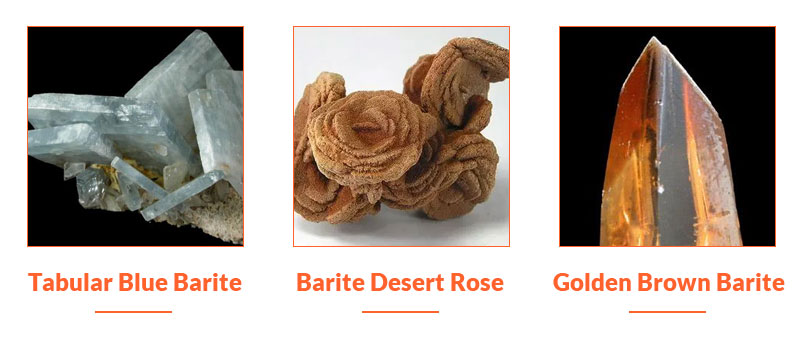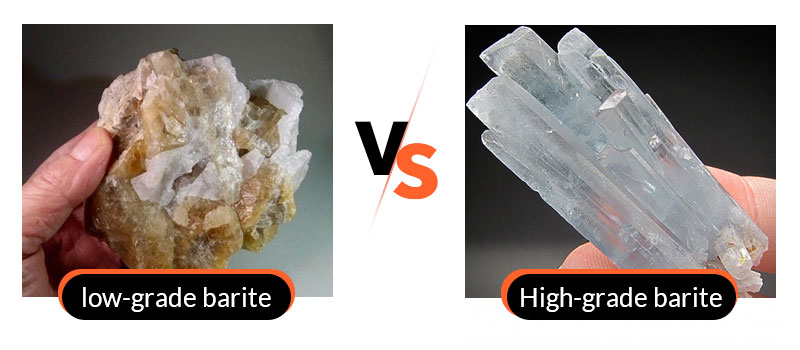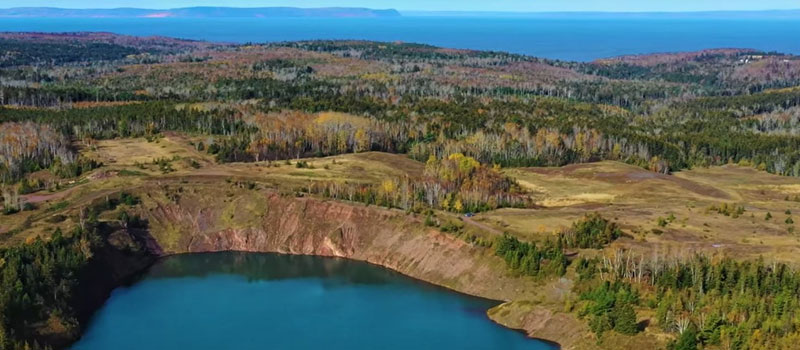Barite, also called baryte, is a non-metallic mineral product with barium sulfate(BaSO4) as the main component. The name of barite comes from the Greek word barys, which means heaviness and implies the weight of this mineral. Because the specific gravity of barite is as high as 4.5, which is very rare in non-metallic minerals. Next, let's get to know the unique barite.
1. Barite forms
Barite belongs to the orthorhombic crystal system, and the crystals are more common in parallel {001} plate-like crystals, sometimes in columnar shapes; often appear as clusters, blocks, granular and other aggregates.
Desert rose mainly refers to mineral aggregates with special forms. Barite can also form aggregates similar to rosettes.
2. Barite grade
Based on purity and specific gravity, barite has been classified into Sp. Gr. up to 3.9, Sp. Gr. 4.0, Sp. Gr. 4.1, Sp. Gr.4.2, and Sp. Gr. 4.3 and above. Each grade is used for certain specific applications.
Grade 3.9: Barite grade up to 3.9 signifies specific gravity of 3.9. Barite is formed by 50/50 ratio of barite and other alternative weighing material such as ilmenite and hematite.
Grade 4.0: Barite grade 4.0 signifies a low-grade oilfield barite with specific gravity of 4.0. Its composition includes 85% to 90% of BaSO4.
Grade 4.1: Barite grade 4.1 signifies specific gravity of 4.1. Its composition includes minimum 90% BaSO4, maximum 2% SiO2, maximum 0.25% Fe2O3 and moisture.
Grade 4.2: Barite grade 4.2 signifies specific gravity of 4.2. Its composition includes minimum 90% BaSO4, maximum 2% SiO2, maximum 0.25% Fe2O3 and 1% moisture.
Grade 4.3: Barite grade 4.3 signifies specific gravity of 4.3. Its composition includes up to 95% of BaSO4, 0.5% of SiO2, 1.2% of Fe2O3 and 0.15% moisture.
Grade 4.4 and above: Barite grade 4.4 and above signifies specific gravity of 4.4 and more than 4.4 g/m3. Its composition includes more than 95% of BaSO4, 0.5% of SiO2, 1.2% of Fe2O3 and 0.15% moisture.
The easy way to measure the quality of barite is to look at the transparency of barite. High-quality ones are colorless and transparent. Those containing impurities will be dyed in various colors, often gray, light red, light yellow, etc.
3. Physical and Chemical Properties of Barite
| Chemical composition | Mainly BaSO4, may contain calcium and other impurities |
| Chemical classification | Sulfate |
| Mohs hardness | 3-3.5 |
| Specific Gravity | 3.9-4.6 |
| Crystal type | Orthorhombic crystal |
| Luster | Vitreous to pearly |
| Color | Colorless, white, gray, light blue, light yellow, light red, light green |
| Diaphaneity | Transparent to opaque |
| Streak | White |
| Radioactivity | Non-radioactive |
| Magnetic | Non-magnetic |
Note: barite can absorb X-rays and γ rays.
4. Is barite a hazardous material?
The main component of barite is barium sulfate which is neither soluble in water nor acid, so even if it is eaten in the stomach, it will not produce toxic barium ions.
However, if the human body absorbs pure barium sulfate powders, it can cause pain and tightness in the chest, coughing, etc. Long-term inhalation can cause barium pneumoconiosis. Barium sulfate powder can also stimulate the eyes.
5. Associated minerals of barite
Fluorite, calcite, quartz, sphalerite, vanadinite, pyrite, galena, dolomite, antimonite, chalcopyrite, clay minerals, hematite, siderite, specularite, witherite, sulfide, etc.
6. Geology of the Barite Deposits
6.1 Hydrothermal Barite Deposit
Hydrothermal barite deposits are often found in the fractured structures of sedimentary rocks, metamorphic rocks, and magmatic rocks in the form of steeply inclined veins.
Barite ore bodies appear in groups and belts, ranging from tens of meters to more than 2,000 meters in length, and extending from tens to hundreds of meters in depth. The mineral composition in hydrothermal barite ore is relatively simple. According to the mineral composition, there are five combinations of hydrothermal barite ore: barite single mineral composition, quartz-barite combination, fluorite-barite combination, polymetallic sulfide-barite combination, witherite-barytocalcite-barite combination. It is often associated with lead, zinc, copper, pyrite, fluorite, witherite, etc.
The mineral composition in hydrothermal barite ore is relatively simple. According to the mineral composition, there are five combinations of hydrothermal barite ore: barite single mineral composition, quartz-barite combination, fluorite-barite combination, polymetallic sulfide-barite combination, witherite-barytocalcite-barite combination. It is often associated with lead, zinc, copper, pyrite, fluorite, witherite, etc.
There are small and medium-sized hydrothermal barite deposits, which have tremendous industrial value.
6.2 Bedded Barite Deposits
The bedded barite deposits can also be called layered deposits according to their occurrence characteristics. Such deposits are formed in the Early and Middle Paleozoic sedimentary rock series. The individual beds of barite are layered, layered-like, and lenticular and range in thickness from a few inches to about 10 feet, with color generally light to dark grey. Sedimentary barite is associated with quartz and chert; pyrite and secondary iron oxides; dolomite, calcite, siderite, witherite and strontianite; and clay minerals.
There are large-scale, medium-scale and small-scale sedimentary barite deposits, which have certain industrial value.
6.3 Bedded-Volcanic Barite Deposits
Volcanic sedimentary barite deposits are mostly distributed in the Neoproterozoic metamorphic rock series of the Qilian Fold System. The main minerals and associated minerals are barite, pyrite, chalcopyrite, galena, sphalerite, hematite, fluorite, witherite, calcite, dolomite, quartz, etc. In addition, volcanic-sedimentary barite deposits also occur around clay nodules, sedimentary rock formations, and hot springs.
There are large-scale, medium-scale, and small-scale volcanic sedimentary barite deposits. They all have a practical industrial value.
6.4 Residual Barite Deposits
After the primary barite deposits have been exposed to the surface, under the action of continuous and alternating weathering, denudation, and leaching, the residual barite ore formed. Residual barite mines have an area of thousands to hundreds of thousands of square meters, a thickness of tens of centimeters to three meters, and a buried depth of tens of centimeters to two meters. Residual barite contains a large amount of surrounding rock fragments, clay, and a small amount of quartz and calcite.
Residual barite deposits are mostly small in scale, rarely medium-sized, and have low industrial significance.
The barite resources are rich worldwide, with proven barite reserves of 2 billion tons. And the distribution of resources is relatively concentrated. The global barite resources are only distributed in a few countries such as China, Kazakhstan, Turkey, India, Iran, and the United States. China ranks first in the world.










